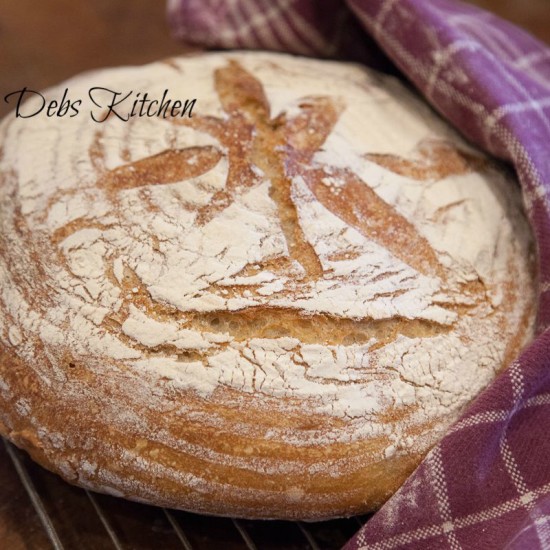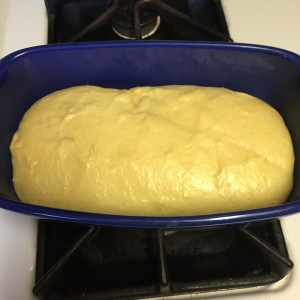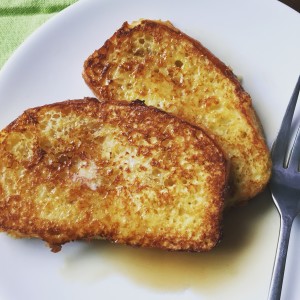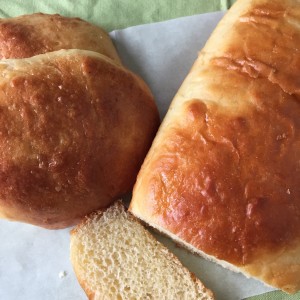Add yeast and salt to the water in a 5-quart bowl or, preferably, in a resealable, lidded (not airtight) plastic food container or food-grade bucket
Mix in the flour—kneading is unnecessary: Add all of the flour at once.
Mix with a wooden spoon, a high-capacity food processor (14 cups or larger) fitted with the dough attachment, or a heavy-duty stand mixer fitted with the dough hook until the mixture is uniform. If you’re hand-mixing and it becomes too difficult to incorporate all the flour with the spoon, you can reach into your mixing vessel with very wet hands and press the mixture together. Don’t knead! It isn’t necessary. You’re finished when everything is uniformly moist, without dry patches. This step is in a matter of minutes, and will yield a dough that is wet and loose enough to conform to the shape of its container.
(I placed dough onto parchment paper and baked it on parchment in a Dutch oven.)
Cover with a lid (not airtight) or a towel. Do not use screw-topped bottles or Mason jars, which could explode from the trapped gases. Lidded plastic buckets designed for dough storage are readily available. Allow the mixture to rise at room temperature until it begins to collapse (or at least flattens on the top), approximately 2 hours. Longer rising times, up to about 5 hours, will not harm the result. You can use a portion of the dough any time after this period. Fully refrigerated wet dough is less sticky and is easier to work with than dough at room temperature. So, the first time you try our method, it’s best to refrigerate the dough overnight (or at least 3 hours), before shaping a loaf.
BAKING
Cut a piece of parchment paper a little bigger than a notebook size of paper, dust with a little flour.
Dust the surface of your refrigerated dough with flour. Pull up and cut off a 1-pound (grapefruit-size) piece of dough, using a serrated knife. Hold the mass of dough in your hands and add a little more flour as needed so it won’t stick to your hands. It will be very sticky. Gently stretch the surface of the dough around to the bottom on all four sides, rotating the ball a quarter-turn as you go. Most of the dusting flour will fall off; it’s not intended to be incorporated into the dough. The bottom of the loaf may appear to be a collection of bunched ends, but it will flatten out and adhere during resting and baking. The correctly shaped final product will be smooth and cohesive. The entire process should take no more than 30 to 60 seconds.
Rest the loaf and let it rise on the parchment. Allow the loaf to rest for about 40 minutes (it doesn’t need to be covered during. the rest period). Depending on the age of the dough, you may not see much rise during this period; more rising will occur during baking (“oven spring”).
Twenty minutes before baking, preheat the oven to 450°F, with a baking stone placed on the middle rack. Place an empty broiler tray for holding water on any other shelf that won’t interfere with the rising bread.
Debbi's notes: I take a 2 qt. Le Crueset (or any stone-ware or cast iron) Dutch oven and put it in the oven with the lid (make sure if the knob on the lid top is plastic to wrap it in tin foil so it doesn't melt). Let it preheat with the oven. When the oven is hot and the dough is ready pick up the parchment paper and plop it into the hot Dutch oven pan, Put the lid back on and carefully slide it into the oven. Alternatively you could slide the dough, still on the parchment paper, onto a pizza or baking stone that you heated with the oven.
Dust and slash: Unless otherwise indicated in a specific recipe, dust the top of the loaf liberally with flour, which will allow the slashing knife to pass without sticking. Slash a ¼-inch-deep cross, “scallop,” or tic-tac toe pattern into the top, using a serrated bread knife.
Bake for about 30 minutes, or until the crust is nicely browned and firm to the touch. Because you’ve used wet dough, there is little risk of drying out the interior, despite the dark crust. When you remove the loaf from the oven, it will audibly crackle, or “sing,” when initially exposed to room-temperature air. Allow to cool completely, preferably on a wire cooling rack, for best flavor, texture, and slicing. The perfect crust may initially soften, but will firm up again when cooled.
I found that it may take more than 30 minutes to bake, up to 40 to completely bake the inside. If you can use a hot pad and turn the bread over in your hand, tap the bottom of the loaf with your finger, it should make a hollow sound. If it's still a little soft, return it to the oven for a few minutes.
Store the remaining dough in the refrigerator in your lidded (not airtight) container and use it over the next 14 days: You’ll find that even one day’s storage improves the flavor and texture of your bread. This maturation continues over the 14-day storage period. Refrigerate unused dough in a lidded storage container (again, not airtight). If you mixed your dough in this container, you’ve avoided some cleanup. Cut off and shape more loaves as you need them. We often have several types of dough storing in the refrigerator at once. The dough can also be frozen in 1-pound portions in an airtight container and defrosted overnight in the refrigerator prior to baking day.
FOR PIZZA:
Pinch off a palm sized piece of dough, shape into a round, rectangular or square shape. Dough is sticky so keep some extra flour nearby, dust your hands as necessary to shape the dough. If the dough starts to snap back you should let it rest for a few minutes and then resume shaping.
Place onto parchment paper, a dusted pizza peel or the bottom of a dusted baking sheet. You can use anything you want providing the pizza can slip right off onto the rack.
If you are baking in an oven, preheat your oven to 500° or as high as it will go. Top the dough with anything you like, slid it into the hot oven and bake for 12-14 minutes.
If you are grilling dough, preheat bbq to high. Slide dough onto rack and cook 5-10 minutes on one side. Remove from grill, top the cooked side and return to the grill. Close the lid so the toppings will cook evenly.
Francois, Zoe; Hertzberg, Jeff , MD (2007-11-13). Artisan Bread in Five Minutes a Day: The Discovery That Revolutionizes Home Baking (pp. 26-27). Macmillan. Kindle Edition.





